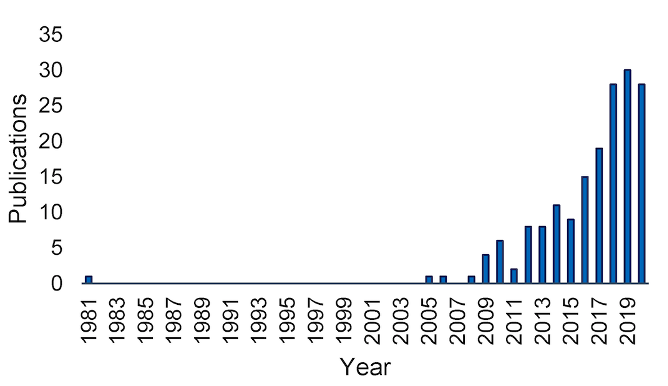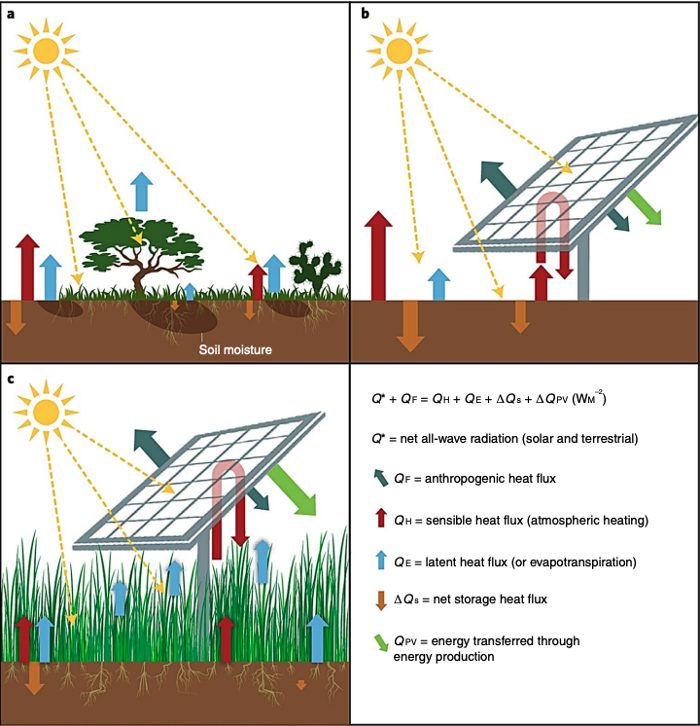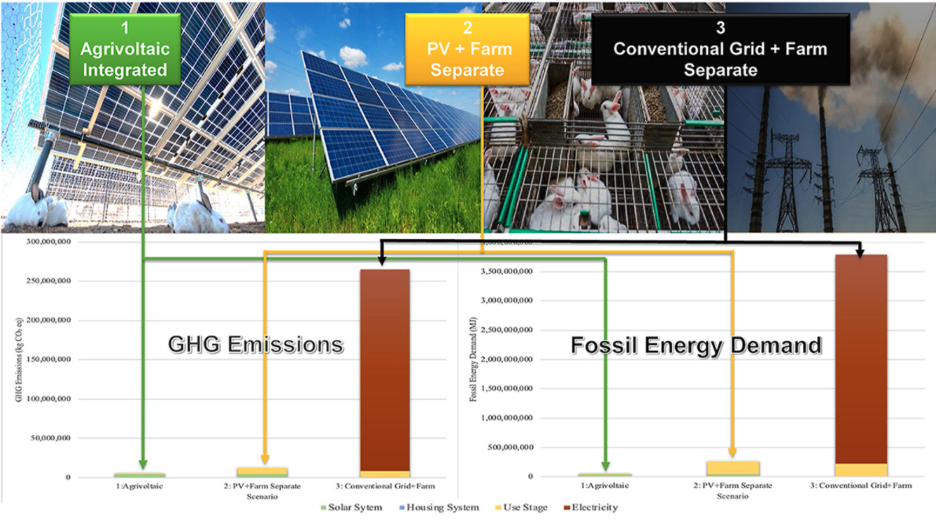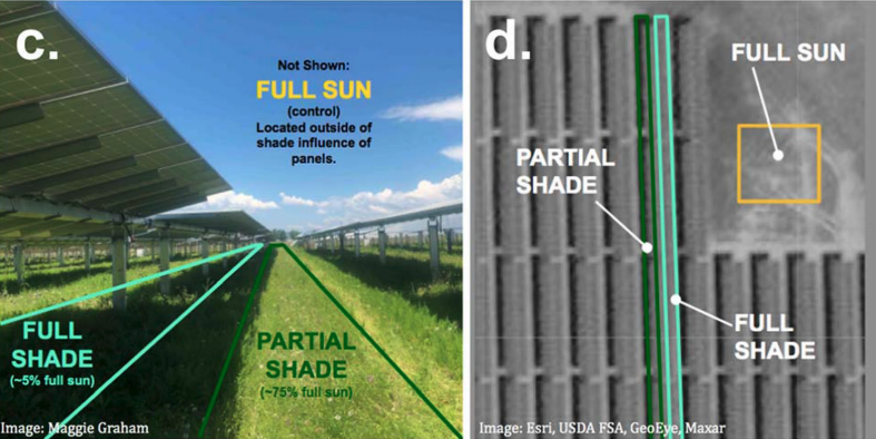Energy Innovation partners with the independent nonprofit Aspen Global Change Institute (AGCI) to provide climate and energy research updates, and a full list of AGCI’s quarterly research updates covering recent climate change research on clean energy pathways is available online at https://www.agci.org/solutions/quarterly-research-reviews
Solar photovoltaic (PV) technology is pivotal in the transition to a low-carbon energy system. Yet wide-scale deployment may be hindered due to fears about sustainability tradeoffs and pockets of social resistance. For instance, deployment of PV farms can compete with agriculture for the use of the same land for food production and may create local tensions about how land is used and allocated.
However, an emerging strategy known as agrivoltaics combines solar electricity generation with agricultural production in the same location. As shown in Figure 1, more and more research is evaluating agrivoltaics for its potential to enhance land-use efficiency, climate solutions, sustainable food, and local economies. Different agrivoltaic configurations—such as combining PV with croplands, pastures, or pollinator habitats—may contribute to achieving sustainable energy and food goals simultaneously, while possibly reducing local opposition to PV deployment. This article reviews a few recent studies that uncover what researchers are finding about the myriad potential benefits of agrivoltaics.

Agrivoltaic systems are shown to increase crop production, among other benefits, in drylands
A study by Barron-Gafford and colleagues compared the food, energy, and water implications of an agrivoltaic system to a traditional agriculture system in Arizona. Across the plants examined (chiltepin pepper, jalapeño, and cherry tomato), fruit production doubled in the agrivoltaic system relative to the traditional environment. Due to the cooling effect of plant transpiration on the solar panels (Figure 2), there were also marginal improvements to electricity production. The agrivoltaic PV system generated 1 percent more electricity on an annual basis (3 percent increase during summer months) compared to a regular PV system in the same location. Additionally, carbon dioxide uptake and water use efficiency were also both higher (both by 65 percent) in the agrivoltaic system, which the authors suggest aided overall productivity by reducing plant stress due to heat and drought.

Agrivoltaic systems can support economic development of rural communities in developing countries
A recent study conducted by Choi and collaborators sought to estimate the benefits of implementing agrivoltaics in rural communities in low- and middle-income countries. The authors selected Indonesia as a test case and applied a life cycle analysis approach to estimate the effects of different land-use scenarios on greenhouse gas emissions, income, and environmental co-benefits.
The model-based results showed that “small-scale agrivoltaic systems are economically viable in certain configurations and can potentially provide co-benefits including rural electrification, retrofitting diesel electricity generation, and providing electricity for local processing of agricultural products.” The authors also noted the barrier of high capital expenditures solar, which currently may be difficult to justify absent increases in subsidies for solar or reductions in subsidies for fossil fuels.
Pasture-based agricultural processes may also be improved through agrivoltaics
Relatively less research has explored how agrivoltaics could work in pasture settings. An April 2021 research article by Andrew and colleagues in Frontiers in Sustainable Food Systems conducted an experiment that monitored sheep grazing on both agrivoltaic and traditional pastures open over two years. Predictably, shady plots with solar panels generated less herbage than the sunnier, open pastures. However, lambs in both the traditional and agrivoltaic plots gained weight at nearly the same rate. The authors found reduced quantity in herbage due was made up for by higher quality forage in shady areas, possibly alongside reduced heat stress and more effective foraging behavior when sheep roamed among the PV panels. All told the comparable outcomes in lamb production between the two treatments indicate opportunities for improved land-use efficiency in an agrivoltaic pasture system.
A related study explored the opportunities of shifting conventional animal feeding operations and conventional PV farms to pasture-based arrangements that integrate PV. In Cleaner and Responsible Consumption, Pascaris and colleagues explored this potential using life cycle analysis on different scenarios of rabbit and electricity production (as shown in Figure 3). When comparing emissions from the energy utilized to mow grass in conventional PV farms and supply processed feed for conventional rabbit farms, the authors estimated substantial reductions in emissions by converting to an agrivoltaic configuration. In the agrigvoltaic scenario, rabbits fed on natural grass, eliminating the need for additional feedstock or mowing operations, resulting in sizable emissions reductions gains.

Agrivoltaic systems can restore pollinator habitat
Relative to PV with crops or PV with pasture, the most widely deployed form of dual-use PV in the United States to date is called “pollinator-friendly PV.” This type of agrivoltaic strategy installs solar arrays on top of pollinator habitat, which according to the National Renewable Energy Laboratory (NREL) is already utilized in more than 1 gigawatt of U.S. PV installations. A field study by Graham and colleagues published earlier this year in Nature Scientific Reports compared the composition and behavior of foraging pollinators between fully and partially shaded plots under solar arrays and on full-sun (control) plots at the Eagle Point Solar Plant in southwestern Oregon (Figure 4). Although the fully shaded areas directly beneath the panels attracted far fewer pollinating insects, the researchers observed more types and greater numbers of insects in the partial-shade plots, relative to the full-sun plots, at certain times throughout the growing season. Although pollinators were observed to actually visit plants at comparable rates between each of the treatment areas, some plants in the partial shade plots bloomed later, which the authors suggested could benefit late-season pollinators.

Agrivoltaic systems may improve public support for solar PV development
In a May 2021 pre-print posted to SocArXiv (open archive of social science research not yet under peer-review), Pascaris and colleagues reported on a survey of nearly 200 respondents across in Lubbock County, TX and Houghton County, MI. Although most of these respondents already expressed favorable attitudes toward solar deployment (72 percent), a marginally higher percentage (81 percent) indicated they would be even more supportive of local solar installations if they were combined with agriculture production. Although the results signaled that agrivoltaic proposals could further reduce local opposition, they also tracked the considerations important to communities when deliberating over solar projects – namely, that proposed agrivoltaic projects need to take into account local concerns such as how the project would provide economic benefits to farmers, the fairness in how economic benefits are distributed, the details of the siting of any new installations, and the overall alignment with local interests.
Conclusion
What can we take away from these recent studies? At the very least, each showcases the ability for agrivoltaics to increase land-use efficiency without sacrificing much in the way of either energy or food production. Furthermore, many agrivoltaic configurations appear even to enhance both food and energy production while at the same time reducing the environmental impact from pursuing each activity as a standalone.
While this area of research is still advancing, findings from these particular studies can help to inform optimal designs and standards for emerging applications of agrivoltaics. To date, little support and guidance on best-practice implementation, let alone policy, exists to foster agrivoltaic deployment. Yet if current signals in research hold up, agrivoltaics may help low-carbon energy to become synergistic with, rather than competitive with, other sustainable development goals.